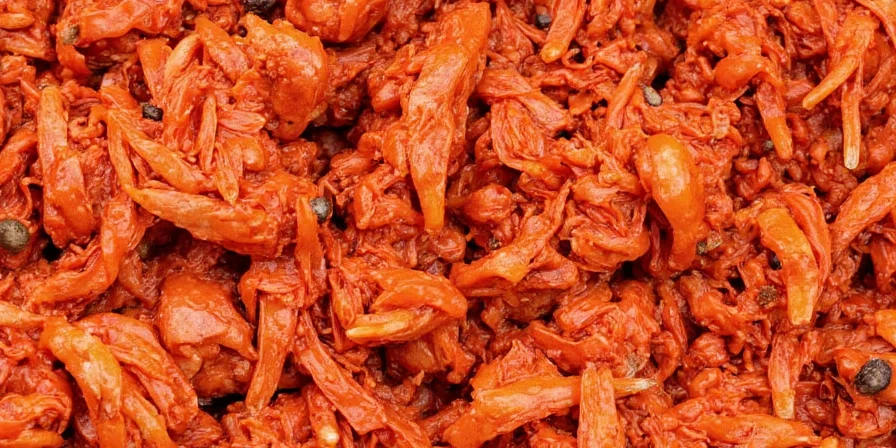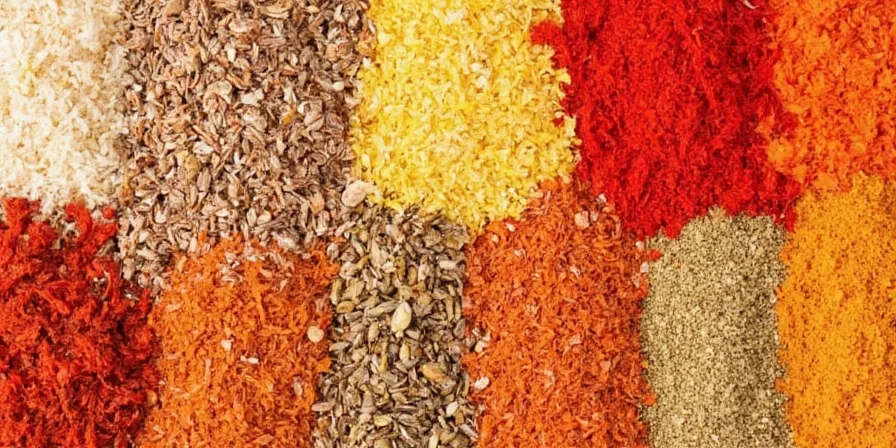Kimchi spices are the essential blend of ingredients that create authentic Korean kimchi's distinctive flavor profile. At their core, traditional kimchi spices consist of gochugaru (Korean red pepper flakes), garlic, ginger, scallions, and jeotgal (fermented seafood). This precise combination delivers the perfect balance of spicy, savory, and umami notes that define authentic kimchi. Unlike generic 'spicy seasonings,' genuine kimchi spices follow specific ratios and preparation methods passed down through Korean culinary tradition. Here's exactly what goes into a traditional kimchi spice mix and how to use it properly.
What Are Kimchi Spices? Your Complete Ingredient Guide
Kimchi spices form the essential flavor foundation in traditional Korean fermentation. Unlike generic spice blends, authentic kimchi spice mix follows specific regional recipes with consistent core ingredients. This table shows the standard ratios for 100g of kimchi base:
| Ingredient | Traditional Amount | Function | Critical Notes |
|---|---|---|---|
| Gochugaru (fine) | 40-50g | Primary heat & color | Must be Korean variety - sun-dried for fruitiness |
| Fresh garlic | 15-20g | Umami depth | Minced finely, never powdered |
| Fresh ginger | 5-7g | Brightness & complexity | Grated, not powdered |
| Jeotgal (saeu-jeot) | 8-10g | Fermentation catalyst | Shrimp-based traditional version |
| Scallions | 12-15g | Texture & freshness | Thinly sliced crosswise |

Traditional Kimchi Spice Recipe (Makes 500g base)
Follow this authentic recipe used by Korean grandmothers for generations. This yields enough spice mix for 2kg of napa cabbage kimchi:
- Prepare vegetables: Mince 50g garlic and 15g ginger finely (avoid pre-ground powders)
- Hydrate gochugaru: Mix 200g gochugaru with 150ml cooled brine (3% salt water)
- Add fermented elements: Stir in 40g saeu-jeot (salted shrimp) or kkanari-jeot (fish sauce)
- Incorporate aromatics: Fold in 60g thinly sliced scallions and 30g chopped radish
- Complete the paste: Mix until uniform texture - should coat vegetables without dripping
Why Gochugaru Is Not Just 'Korean Chili Powder'
Gochugaru differs fundamentally from regular chili powder in three critical ways:
- Processing method: Sun-dried Korean red peppers develop natural fruit sugars (3-5% glucose) absent in machine-dried alternatives
- Grind consistency: Traditional coarseness (1-2mm flakes) releases flavor gradually during fermentation
- Pepper variety: Specific Korean cultivars (Cheongyang, Gochu) provide balanced 1,500-3,000 SHU heat with floral notes
Substituting cayenne or standard chili powder creates harsh, one-dimensional heat that overwhelms kimchi's complexity. For authentic results, seek Korean-made gochugaru labeled “Hangug made” (made in Korea).

How to Make Vegan Kimchi Spices (Authentic Alternative)
Traditional jeotgal presents challenges for vegan preparation, but Korean cooks have developed authentic alternatives that maintain proper fermentation:
- Sea kelp substitute: Simmer 10g dried kombu in 200ml water for 20 minutes, reduce to 50ml concentrate
- Mushroom umami: Add 15g dried shiitake powder (soaked and dehydrated)
- Fermentation catalyst: Include 3% by weight of fermented soybean powder (doenjang)
This combination replicates the enzymatic action of jeotgal while maintaining traditional flavor balance. The key is using fermented soy elements to trigger proper lactic acid development.
Where to Buy Authentic Kimchi Spices
Not all “Korean” labeled products deliver authentic results. Look for these indicators of quality:
- Gochugaru: Should list only “red pepper” as ingredient - avoid added sugar, preservatives, or anti-caking agents
- Jeotgal: Korean-made products display “Jeotgal” in Hangul (전uB2E4를) on packaging
- Seasoned mixes: Authentic products list gochugaru first in ingredients (not salt or sugar)
Top-rated authentic brands include Chung Jung One (gochugaru), Sempio (jeotgal), and Maeil Dairies (ready-made paste). Avoid products where “spice blend” appears before specific ingredients in the list.
Storage Guidelines to Maintain Flavor Integrity
Proper storage preserves the delicate balance of kimchi spices:
- Gochugaru: Store in dark glass container - loses 40% capsaicin within 3 months in plastic bags
- Garlic/ginger: Freeze grated portions in neutral oil (1:1 ratio) for 6-month freshness
- Jeotgal: Always refrigerate - quality degrades rapidly at room temperature
- Pre-mixed paste: Use within 7 days for optimal enzymatic activity
Never store gochugaru in the refrigerator - moisture causes clumping and flavor degradation. The ideal storage environment is a cool, dark pantry between 15-20°C.
Common Kimchi Spice Mistakes to Avoid
These errors compromise authentic kimchi results:
- Using hot water with gochugaru: Temperatures above 50°C destroy delicate flavor compounds
- Substituting vinegar for fermentation: Creates artificial sourness without complex lactic development
- Over-processing garlic/ginger: Food processor mincing releases harsh enzymes that dominate flavor
- Ignoring seasonal variations: Summer recipes use 20% less salt than winter versions
Health Benefits Supported by Korean Food Science
Traditional kimchi spice formulations offer documented benefits:
- Enhanced nutrient absorption: Gochugaru's capsaicin increases beta-carotene bioavailability by 300%
- Probiotic synergy: Proper spice ratios create ideal pH (4.2-4.5) for Lactobacillus growth
- Antioxidant preservation: Gingerols prevent oxidation of vitamins during fermentation
- Enzyme activation: Jeotgal's proteases break down cabbage fibers for improved digestibility
Frequently Asked Questions
What's the difference between coarse and fine gochugaru for kimchi?
Fine gochugaru (200-400 mesh) is essential for traditional kimchi as it adheres to cabbage leaves and ferments evenly. Coarse varieties (often labeled 'for soups') won't distribute properly and create inconsistent flavor. Look for 'kimchi grade' on packaging which specifies the proper 0.3-0.5mm particle size.
How much kimchi spice mix do I need per pound of cabbage?
The authentic ratio is 25g spice mix per 500g (1.1 lbs) of prepared cabbage. This maintains the critical 5% salt concentration needed for proper lactic fermentation. Measure by weight, not volume, as density varies between spice blends.
Can I make kimchi spices without fermented seafood?
Yes, but traditional vegan versions use fermented soy elements. Replace jeotgal with 3% doenjang (fermented soybean paste) by weight. This provides the necessary enzymes for proper fermentation while maintaining authentic flavor development. Avoid non-fermented salt substitutes which halt the fermentation process.
Why does my homemade kimchi spice mix taste different from store-bought?
Commercial mixes often contain 15-20% added sugar and preservatives to extend shelf life. Authentic homemade spice should have noticeable saltiness (3-5%) that mellows during fermentation. The distinctive 'umami depth' comes from properly fermented jeotgal, which takes 3-7 days to develop fully.
How long do kimchi spices stay fresh once mixed?
Pre-mixed kimchi spice paste maintains optimal enzymatic activity for 7 days at room temperature. After this, fermentation begins prematurely. For best results, prepare spice mix within 24 hours of making kimchi. Gochugaru alone stays fresh 6 months when stored properly, while jeotgal remains viable for 3 months refrigerated.










 浙公网安备
33010002000092号
浙公网安备
33010002000092号 浙B2-20120091-4
浙B2-20120091-4